
The Commission on Particles and Fields (C11) was established in 1957. The aim of particle physics is to study the smallest structures of matter and interactions, both experimentally and theoretically. Particle interactions at high energy scales have beautiful mathematical structures called “symmetries” and are described by quantum field theories. Surprisingly, these smallest particles influence the large scale structure of the universe and vice versa.
High energy collider experiments have shown that there are many fundamental particles, and some of them are more than 100 times heavier a proton. Among those fundamental particles, the most mysterious is the Higgs boson that was found in 2012 at the Large Hadron Collider (LHC) at CERN. It is responsible for generating the masses of most of the fundamental particles. Other mysteries include differences between matter and anti-matter – why are they different at all? and the nature of dark matter – which we know is more common than ordinary matter but still have not been caught in our detectors.
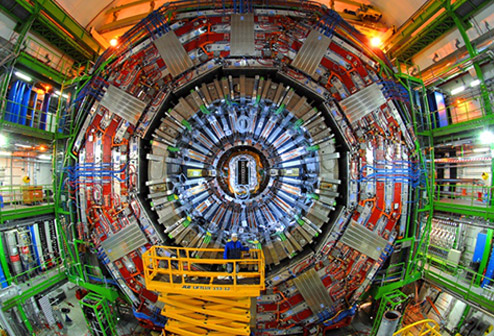
(CMS detector at CERN. ©CERN)
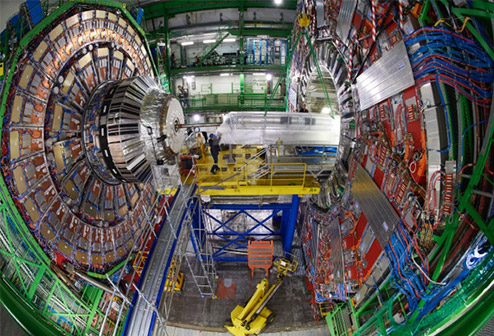
(CMS detector at CERN. ©CERN)
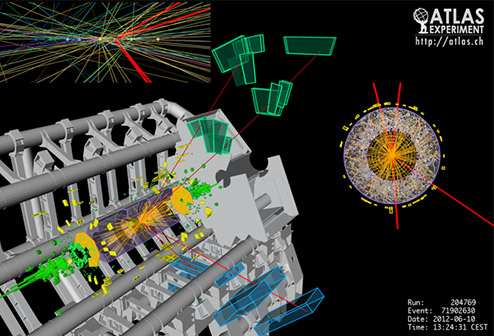
(Higgs boson captured at ATLAS detector at CERN. ©CERN)
Particle physics is now both moving to the higher intensity and higher energy machines to study the nature of the Higgs boson in depth and search for new massive or rarely produced particles, and underground to study neutrino interactions and to possibly detect dark matter in ultra-clean environments. Particle theory is important to guide experiments, and it also plays a key role in connecting particle physics with cosmology, gravity, and the ultimate physical laws at the beginning of the Universe.
High Energy physics has a long history of international collaboration and we must collaborate to afford the massive but precise detectors needed to study elementary particles. Modern high energy physics experiments bring together hundreds of scientists from dozens of nations to work together on common projects. Our mission in C11 is to assure that scientists are able to freely travel and share their work. As part of this mission IUPAP C11 supports and monitors major international conferences and encourages inclusion of younger scientists, women and scientists from developing countries. As the international body for the field, C11 also convenes working groups and panels such as the International Committee on Future Accelerators to provide a forum for international coordination.
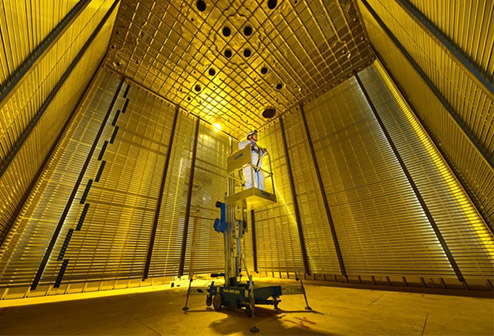
(Construction of the protoDUNE liquid argon detector at CERN, © CERN)
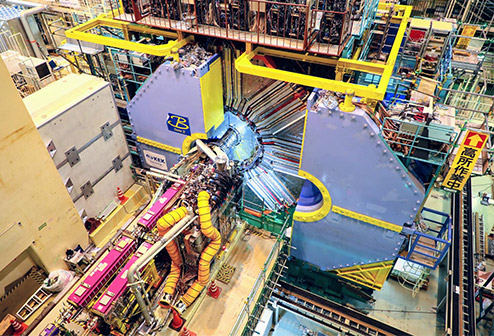
(Belle II detector at KEK will study bottom quark nature in detail © KEK)
Mission/Mandate
Article
1
To promote the exchange of information and views among the members of the international scientific community in the general field of Particles and Fields including:
- The theory and experiment concerned with the nature and properties of the fundamental constituents of matter and the forces acting between these constituents;
- The maintaining of liaison with ICFA;
- The accelerators, detectors and techniques used in these investigations;
- The industrial applications of relevant technologies.
Article
2
To recommend for Union sponsorship international conferences which qualify for support under Union regulations.
To initiate such conferences as their need arises from the evolution of the Commission field.
To assist in the organization of such conferences when practical. To ensure the compatibility of international conferences in its field and to discourage clashes and incompatibility of dates.
Article
3
To promote the free circulation of scientists; to assist conference organizers in ensuring such free circulation and in resolving potential infringements.
Article
4
To organize where feasible the award of medals or other testimonials of excellence in its field.
Article
5
To publish where feasible newsletters, circulars, occasional books, journals or handbooks in its area.
Article
6
To maintain liaison with other IUPAP Commissions, with the Commissions or Committees of other Unions or of the International Council of Scientific Unions (ICSU) or other scientific organizations, with a view to collaborating and cooperating in sponsoring joint conferences and to participating in joint projects when need arises.
In particular to maintain close liaison with the General Commissions of IUPAP (SUNAMCO, Physics Education and Development), so as to ensure suitable input from its field into these physics-wide activities.
Article
7
To make available to each General Assembly of the Union a summary of activities and progress in its field since the previous Assembly.
Additional Information
The IUPAP C11 Commission has been a gateway for IUPAP sponsorship for a number of conference series in the area of Particle Physics: ICHEP, Lepton Photon, TIPP, Neutrino and IPAC. The commission has also provided oversight of the ICHEP and Lepton Photon conference series and has been a strong advocate for the TIPP conference series. The IPAC and Neutrino series are interdisciplinary and have independent international organizing groups. C11 encourages organizers of these conferences to seek joint support from related IUPAP commissions such as C12.
C11 has traditionally chosen the location for the ICHEP, Lepton Photon and TIPP conferences; ICHEP locations are generally chosen 4 years ahead of the conference; Lepton Photon and TIPP are usually chosen 3 years ahead. The exact dates for the conferences should be decided and advertised two years ahead. The IUPAP liaison committee for the host country should also be notified in advance of the proposal to C11. https://iupap.org/who-we-are/internal-organization/commissions/c11-particles-and-fields/c11-members/ gives the contact information for C11 and national liaisons are listed at https://iupap.org/who-we-are/internal-organization/members/.
Please see https://iupap.org/conferences/ for general IUPAP guidelines on conferences. Where those guidelines differ from the C11 guidelines below, the general guidelines take precedence.
Conferences proposals are reviewed by the C11 commission at the annual committee meetings (normally ICHEP and LP when they are held in the northern summer) and submitted for review to the IUPAP Council and Commission Chairs. Final approval of IUPAP sponsorship is made by the IUPAP Executive Council when it meets in October. Formal applications for IUPAP sponsorship are due June 1 of the calendar year before the conference: https://iupap.org/conferences/applications/
Conferences wishing only endorsement may apply via https://iupap.org/conferences/applications/application-for-conference-endorsement/ at any time.
Proposals for IUPAP C11 conferences should describe the proposed venue and discuss the availability and accessibility of the conference facilities. The proposal should examine the availability of local hotels and the affordability of housing for participants. C11 expects the proposal to describe the local surroundings, the proposed scientific and social program, the budget and the expected level of local support. A brief description of recent large international conferences hosted by the organization team is also highly relevant.
Since 2020, it has become apparent that provision for remote attendance is very important and, in fact, vital for scientists from less wealthy institutes. At the same time, conventional conference facilities come with significant costs and cancellation penalties which require careful attention to projected in-person attendance. Going forward, C11 is interested in innovative proposals for conferences that allow global participation but provide financial protection to conference sponsors.
IUPAP sponsored international conferences series rotate between different regions. The rotation is not absolutely strict but significant priority is given to bids from regions that next in the rotation. The guidelines for IUPAP conferences are available online: https://iupap.org/conferences/conference-policies/
IUPAP is committed to diversity and expects the international organizing committee to have representation from all regions. IUPAP expects the conference proponents will demonstrate that there are an appropriate number of women among the organizers and in the scientific program. See the general policies for details but the expectation that women will make up at least 20% of participants at all levels; organizers and plenary and invited speakers.
In addition, IUPAP requests that the following statement shall be published by the organizers in any circular or announcement and in the proceedings of the conference:
“To secure IUPAP sponsorship, the organizers have provided assurance that (Conference name) will be conducted in accordance with IUPAP principles as stated in the IUPAP resolution passed by the General Assembly in 2008. In particular, no bona fide scientist will be excluded from participation on the grounds of national origin, nationality, or political considerations unrelated to science.”
Some guidelines for a conference proposal:
- Which IUPAP C11 conference are you proposing to host or requesting sponsorship? (Lepton Photon Symposium, ICHEP, TIPP, IPAC, Neutrino, other) Please include the year.
- Describe the proposed venue with possible alternative sites. Details including the number of seats for the main conference hall and the distance to housing. Are there enough parallel session rooms nearby? Is there room for a large poster session?
- Discuss possibilities for remote participation and the data capabilities of the venue.
- List the local organizing team (if known) and chair. Which local institutions will be providing logistical and administrative support?
- Give an overview of the finances and budget for the meeting including the proposed conference fees for participants. Please include costs for the conference venue and for conference organization. IUPAP sponsored conferences have a restriction on the maximum conference fee – currently 680 Euro for 2018. This exact limit will be re-evaluated at the IUPAP General Assembly in November 2020. What fees will be charged for remote participants?
- Indicate the other organizations that will be providing sponsorship for the conference.
- Outline the availability and affordability of hotels for participants including affordable housing for students and scientists from developing countries.
- Provide a brief overview of ease and affordability of transportation (both long distance and local).
- Briefly describe the large HEP conferences your organization team has recently hosted. Has your institution hosted a C11 sponsored conference in the past?
There are many other considerations C11 evaluates in each conference proposal. At least a few items listed below need to be addressed in the proposal for a C11 sponsored conferences:
- Commitment to diversity – outline any strategy for including scientists from underrepresented regions to the meeting. Will financial assistance be available?
- Plans for the inclusion of women in the scientific program.
- Sponsorship for prizes for the poster sessions. Poster prizes selection is coordinated by the conference organization team.
- Subsidies for travel for IUPAP Young Scientist prize winners (ICHEP). It has been traditional that the two prize winners are invited to give a short plenary presentation
- Description of possible satellite meetings.
- Planned outreach events including additional sponsorship
- Social program for conference attendees.
- Programs for attracting and supporting students
- Programs for accompanying persons.
- Tourist attractions in the local area and region.
- Availability and affordability of childcare during the conference. Direct childcare provision is not required but provision of information and assistance in finding local carers is an important consideration.
C11 meetings are scheduled once per year during the major IUPAP C11 conferences – either at ICHEP or Lepton Photon. Proposals for C11 sponsorship are reviewed at the annual C11 meetings.
Potential organizers of future conferences are welcome to attend to learn from the experience of other conferences. Conference proponents will be asked to make a brief oral presentation (with slides) to C11 members. A short written document (1-5 pages) answering the above questions is also encouraged. Written documentation should be submitted to the C11 chair or the secretary at least 2 weeks in advance of the meeting, if possible.
C11 expects conference proponents will adhere to IUPAP guidelines. C11 will evaluate the proposals taking into account various criteria including the venue, recent regional rotation of the conference series and many other items outlined in the IUPAP and C11 conference guidelines.
Proposal to C11 for IUPAP Sponsored Conferences (some suggested sections):
- Proposed date(s)
- Scientific Program Format
- Local Organization
- International Organization Participation
- Venue
- Remote capabilities
- Transportation
- Administrative Support
- Accommodations
- Finances
- Proceedings
- Social Program
Formal applications for IUPAP sponsorship (which includes a small financial contribution for major conferences) are due June 1 of the calendar year before the conference. The form is online:
https://iupap.org/conferences/applications/application-for-conference-sponsorship/
Final decision on IUPAP sponsorship is made by the IUPAP Executive Council meeting in the Fall of the year before the conference.
Following C11 provisional approval, conference organizers will be requested to give status reports at the annual C11 meetings leading up to the conference and a final report at the meeting following the conference. For example, ICHEP and Lepton Photon organizers will be asked to present a short report at the C11 meeting that is co-located at the conference and a final review at the following C11 meeting. C11 expects to have an opportunity to comment on the composition of the International Organizing Committee and can assist in finding members to enhance regional and gender diversity. Final reports should include a short summary of the scientific highlights, attendance figures by gender, region and nationality, and a summary financial report.
In addition, IUPAP also requires a final conference report. The form for this report is available online: https://iupap.org/conferences/conference-report-form/. When preparing registration forms for your conference, please remember to review the reporting form so that all appropriate demographic information can be gathered.
Please send updated information and corrections to the IUPAP Administrator.




